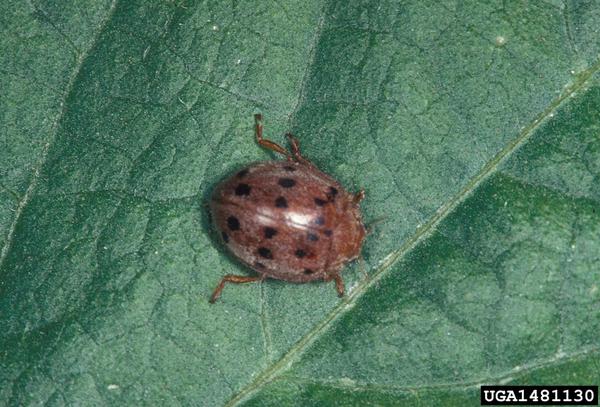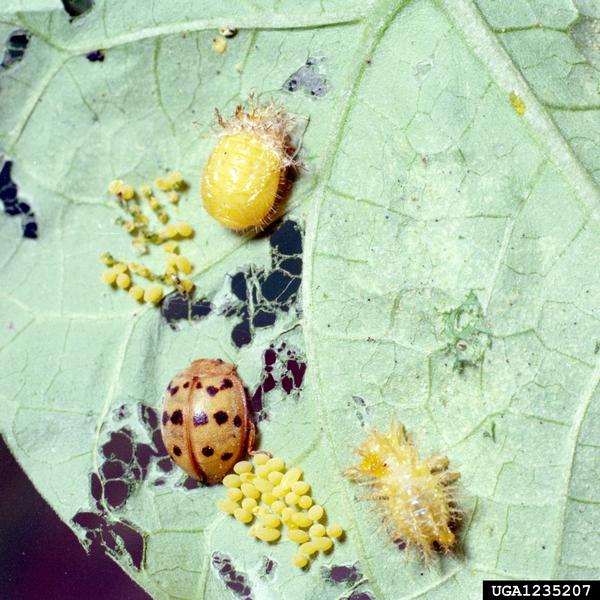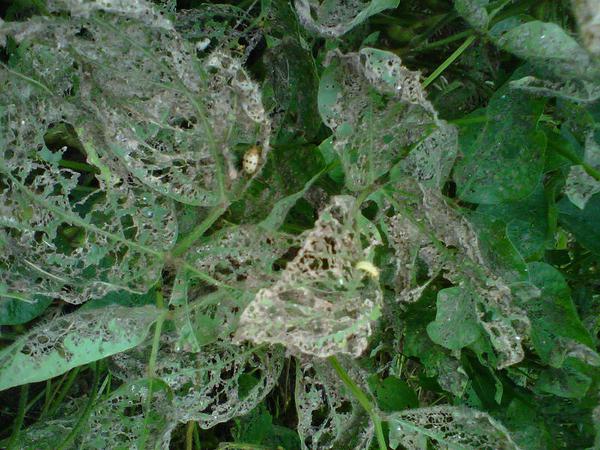Mexican bean beetle
(Epilachna varivestis Mulsant) Chrysomelidae: Coleoptera
Biology and identification
Adults are copper to yellow, rounded beetles with 16 black spots on their backs. Larvae are yellow, oval, soft-bodied, grub-like insects with darker, branched spines. This insect overwinters as an adult and lays yellow colored eggs vertically in masses on the underside of soybean leaves. There is only one generation a year, and there are four larval stages.
Injury and damage
Larvae and adults will feed on all parts of the plant, but injury is generally most severe on the foliage. Younger leaf tissue is preferred. Beetles feed between the leaf veins, causing a lacy appearance in heavily injured leaves. Because they feed on the underside of the leaf, patchy yellow and brown areas can often be visible on the tops of injured leaves. Mexican bean beetles attack soybeans throughout the season, but most damage occurs in August and September. Mexican bean beetles typically do not cause economic damage in North Carolina, but occasional severe infestations occur, especially in unusually cool, cloudy summers.
Economic threshold
The threshold for defoliating insects is 30% defoliation throughout the plant canopy two weeks prior to blooming (R1) and 15% defoliation throughout the plant canopy two weeks prior to flowering (stage varies) until the pods have filled (R7-R8). Vegetative soybeans are tolerant of adult feeding and, as seedlings become larger and faster growing, this foliage loss is seldom of concern. Recent studies have demonstrated that soybeans can tolerate nearly 100% foliage loss during the early vegetative stages before yield loss is achieved.
Management
Recommended insecticides can be found in the North Carolina Agricultural Chemicals Manual.
Publication date: April 3, 2020
Recommendations for the use of agricultural chemicals are included in this publication as a convenience to the reader. The use of brand names and any mention or listing of commercial products or services in this publication does not imply endorsement by NC State University or N.C. A&T State University nor discrimination against similar products or services not mentioned. Individuals who use agricultural chemicals are responsible for ensuring that the intended use complies with current regulations and conforms to the product label. Be sure to obtain current information about usage regulations and examine a current product label before applying any chemical. For assistance, contact your local N.C. Cooperative Extension county center.
N.C. Cooperative Extension prohibits discrimination and harassment regardless of age, color, disability, family and marital status, gender identity, national origin, political beliefs, race, religion, sex (including pregnancy), sexual orientation and veteran status.






